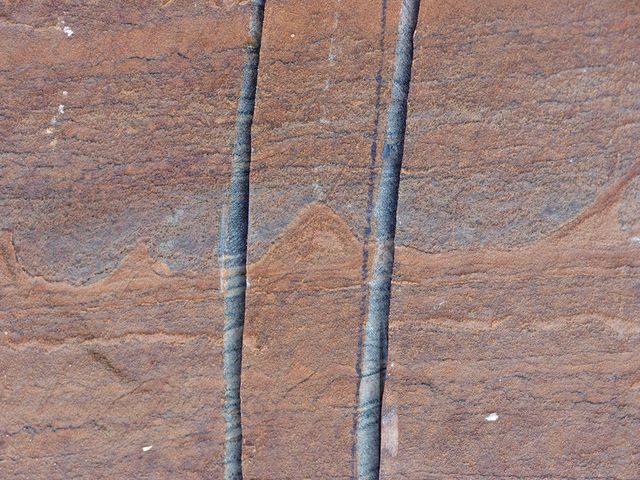Philip Guelpa
Newly discovered bacterial fossils may push back the date of the earliest direct evidence of life on Earth to 3.7 billion years ago, 220 million years older than the previous record. This is roughly four-fifths of the way back to the original formation of the planet, 4.6 billion years ago. If confirmed, this discovery would have tremendous significance for our understanding of the evolution of life in the universe.
The research was published in the August 31 issue of the journal Nature by a team of Australian researchers lead by Allen P. Nutman of the University of Wollongong. They used radiometric dating of volcanic ash deposits to determine the age of the fossil layers.
 Stromatolites found in the Isua area of Greenland are currently the oldest fossil evidence of life on Earth. Credit Allen Nutman
Stromatolites found in the Isua area of Greenland are currently the oldest fossil evidence of life on Earth. Credit Allen Nutman
Patterns in a rock specimen from the Isua formation in southwestern Greenland are interpreted as the fossilized remains of features known as stromatolites. These are the result of ancient bacteria and/or algae (their precise nature has not yet been determined) that lived in water and formed colonial “mats.” The living mats tended to accumulate sedimentary particles or precipitate carbonates which were eventually concreted into solid rock, preserving impressions that are the fossilized remains of these organisms. The newly reported fossils were revealed in bedrock recently exposed by the melting of glacial ice, due to the retreat of the Greenland ice sheet.
It is more than a bit ironic that the discovery of these most ancient organisms, the earliest life forms so far identified, was made as a result of global warming, which threatens a mass extinction of life on Earth.
The earliest previously known, and now widely accepted, stromatolites had been found in Western Australia, dating to 3.48 billion years ago. Organisms that create similar formations still exist in certain locations on Earth today.
Some researchers have questioned whether the identified features in the Greenland rocks are actually biological fossils, noting that the rock formations in which they are found are metamorphic, having undergone significant modifications under conditions of high pressure and temperature following their sedimentary origins. Thus, the identified features could be artifacts of the metamorphism. There is ongoing research to rule out or confirm this hypothesis.
The authors of the Nature article counter that the observed features are sufficiently distinct as to indicate that they escaped the intense changes suffered by adjacent portions of the rock formation and are indeed the result of biological processes. They cite similarities to the more recent and more widely accepted Australian fossils.
The existence of what were already relatively complex life forms, made up of multi-cellular structures, even if the organization was of a rudimentary character, at such an early stage in Earth’s development, indicates that a significant amount of biological evolution had already taken place. Hence, the actual origin of life on Earth must have occurred even earlier, within the first billion years of Earth’s existence.
Previously, indirect evidence of life, based on chemical traces in rock formations suggestive of biological activity, has been dated to between 3.8 and 3.7 billion years ago. The Greenland fossils fall into that time frame, possibly corroborating the chemical signature.
 Image a shows stromatolites found in Greenland while those in c and d are a younger sample from Western Australia. Image b reveals how the Greenland microbes formed different layers over time. ‘Stroms’ are several overlapping stromatolites. Credit: Nature
Image a shows stromatolites found in Greenland while those in c and d are a younger sample from Western Australia. Image b reveals how the Greenland microbes formed different layers over time. ‘Stroms’ are several overlapping stromatolites. Credit: Nature
Unfortunately, finding direct evidence of even earlier life is highly unlikely. Active geologic processes, such as plate tectonics and metamorphism, have so modified the rocks that made up the early Earth that subtle remnants of the most primitive life forms have likely been obliterated.
If such direct evidence was found, it would provide a great deal of insight into the conditions of early Earth. At that period, terrestrial surfaces were black, consisting of exposed bedrock formed by cooled lava, without soil or any plants or animals. Oceans were green due to large amounts of dissolved iron. Plants had not evolved, meaning there was very little oxygen in either the oceans or atmosphere. The entire planet was toxic to modern life.
The Greenland discovery has substantial implications not only for life on Earth but for the potential for life elsewhere in the universe. It indicates that life can develop early in a planet’s history, possibly less than half a billion years after its formation, and under harsh conditions. Among other things, it suggests that primitive life could have evolved independently on early Mars, a time when the planet’s chemistry and geology were similar to those found on Earth during its early existence.
Given such possibilities, a new question emerges: What is the range of conditions for life to evolve and how often do they occur?
In recent years, astronomical research has demonstrated that planets orbiting other stars are likely a widespread phenomenon. Other research has found a planet orbiting a nearby star at just the right distance to have bodies of liquid water on its surface. It is enticing to think of just how many other solar systems could have planets with conditions similar to early Earth.
No comments:
Post a Comment